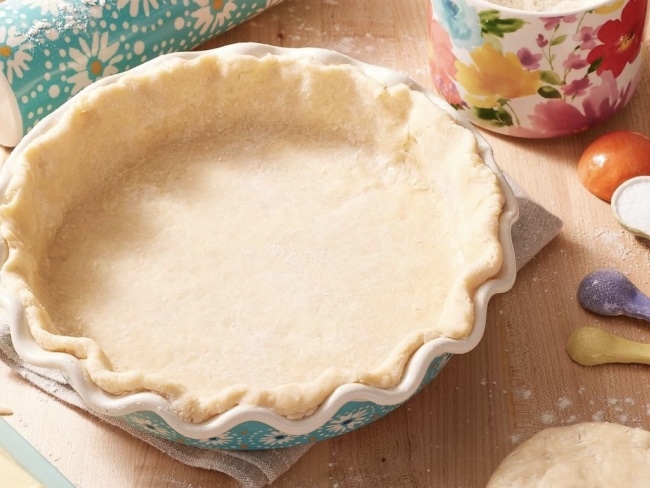How to Make a Grain Pie Crust ?
teaches you all about grain pie crusts. This type of crust can be made with any kind of leftover cooked grain (or grain-like) you have on hand.
Watch Erin demonstrate how to make crispy rice and pasta ones as well as how to put in your savory fillings.
What kind would you make?
How to make pie dough for Thanksgiving ?
Pie dough ingredients
About 30 minutes before you plan to make dough, get your fat and flour good and cold. Place the cubed butter in a small bowl and the flour into a large bowl, then transfer both bowls to the freezer.
Pie dough, food processor
Place the fat, flour and salt in the bowl of a food processor. Pulse 15 times; think of the pulse button as a hot potato, said pie expert Kate McDermott, to keep from overmixing. Add 3 tablespoons of the ice water, holding back the ice cubes. Pulse 10 times. Add 3 more tablespoons of water. Pulse 7 times.
(No food processor? Make by hand. Consider grating the frozen butter with a box grater, especially for your first few pie adventures. Use a bowl large enough for your hands to work comfortably. To blend the fat into the flour, use two forks, a fork-table knife combo, a pastry blender or your fingertips. Think of fluffing in an upwards motion as the flour coats the fat.)
Pie dough making
At this stage, your dough may look like cracker crumbs with unevenly-sized pieces and there may be some lingering flour on the sides of the bowl; that’s OK. Transfer the dough to a large bowl. Drizzle 1 more tablespoon of water on top. Quickly fluff the dough with a fork or your hands. It should start looking shaggy
Pie dough clump
Surround the dough with your hands and form it into a clump. If dough seems dry, dip your fingers into the ice water and quickly pat the dough to moisten. Dump onto a work surface and form it into a large mound that easily sticks together. The dough should feel like cool clay, according to McDermott.
Pie dough ready for rolling
After a two-hour nap in the refrigerator, the dough is ready for rolling. Work with one dough disc at a time. Lightly dust your work surface with flour and on top of the dough. With a rolling pin, pound the dough a few times on each side to soften and wake it up. If dough is sticking to the rolling pin or surface, sprinkle more flour as needed. From the center, roll the dough in quick, even strokes, making a quarter-turn after every few strokes.
Pie dough circle
As you rotate and roll the dough, check to make sure the dough is not sticking. (A dough scraper is helpful at this stage.) When the dough is about 12 inches wide (or a few inches wider than your pie pan), it’s done. Transfer the dough to a pie pan. You can do this by draping dough over the rolling pin or by placing a dough scraper under one side and hoisting it into the pan.
Pie dough fruit in shell
Add filling until it reaches ½ inch below the rim of the pan. Place in the refrigerator while you roll out the second disc, repeating the process as with the first.
Pie dough eggwash and sugar
In a small bowl, fork whisk the egg white and 1 tablespoon of water. Lightly brush all over the pie, including the edges. Sprinkle with sugar. Place the pie on a sheet pan and bake for 20 minutes. Lower heat to 375 F and bake for 40 minutes. The crust should be golden and the filling bubbly.
Pie dough crimped and vented
Lay the remaining dough on top of the fruit, making sure that the edges of both dough layers meet. Trim any overhanging dough with kitchen shears or a paring knife, using any extra dough to patch holes or tears. Do you like to crimp the edges with a fork or create a folded ridge? Now is the time. Make a few slashes on the top of the dough to create vents.
Return to the refrigerator for 20 minutes and preheat the oven to 425 F.
Pie, apple
Kim O’Donnel’s two-crust pie with apple-rosemary filling.
Pie dough ingredients
About 30 minutes before you plan to make dough, get your fat and flour good and cold. Place the cubed butter in a small bowl and the flour into a large bowl, then transfer both bowls to the freezer.
Pie dough, food processor
Place the fat, flour and salt in the bowl of a food processor. Pulse 15 times; think of the pulse button as a hot potato, said pie expert Kate McDermott, to keep from overmixing. Add 3 tablespoons of the ice water, holding back the ice cubes. Pulse 10 times. Add 3 more tablespoons of water. Pulse 7 times.
(No food processor? Make by hand. Consider grating the frozen butter with a box grater, especially for your first few pie adventures. Use a bowl large enough for your hands to work comfortably. To blend the fat into the flour, use two forks, a fork-table knife combo, a pastry blender or your fingertips. Think of fluffing in an upwards motion as the flour coats the fat.)
Pie dough making
At this stage, your dough may look like cracker crumbs with unevenly-sized pieces and there may be some lingering flour on the sides of the bowl; that’s OK. Transfer the dough to a large bowl. Drizzle 1 more tablespoon of water on top. Quickly fluff the dough with a fork or your hands. It should start looking shaggy
Pie dough clump
Surround the dough with your hands and form it into a clump. If dough seems dry, dip your fingers into the ice water and quickly pat the dough to moisten. Dump onto a work surface and form it into a large mound that easily sticks together. The dough should feel like cool clay, according to McDermott.
Pie dough ready for rolling
After a two-hour nap in the refrigerator, the dough is ready for rolling. Work with one dough disc at a time. Lightly dust your work surface with flour and on top of the dough. With a rolling pin, pound the dough a few times on each side to soften and wake it up. If dough is sticking to the rolling pin or surface, sprinkle more flour as needed. From the center, roll the dough in quick, even strokes, making a quarter-turn after every few strokes.
Pie dough circle
As you rotate and roll the dough, check to make sure the dough is not sticking. (A dough scraper is helpful at this stage.) When the dough is about 12 inches wide (or a few inches wider than your pie pan), it’s done. Transfer the dough to a pie pan. You can do this by draping dough over the rolling pin or by placing a dough scraper under one side and hoisting it into the pan.
Pie dough fruit in shell
Add filling until it reaches ½ inch below the rim of the pan. Place in the refrigerator while you roll out the second disc, repeating the process as with the first.
Pie dough eggwash and sugar
In a small bowl, fork whisk the egg white and 1 tablespoon of water. Lightly brush all over the pie, including the edges. Sprinkle with sugar. Place the pie on a sheet pan and bake for 20 minutes. Lower heat to 375 F and bake for 40 minutes. The crust should be golden and the filling bubbly.
Pie dough crimped and vented
Lay the remaining dough on top of the fruit, making sure that the edges of both dough layers meet. Trim any overhanging dough with kitchen shears or a paring knife, using any extra dough to patch holes or tears. Do you like to crimp the edges with a fork or create a folded ridge? Now is the time. Make a few slashes on the top of the dough to create vents.
Return to the refrigerator for 20 minutes and preheat the oven to 425 F.
Pie, apple
Kim O’Donnel’s two-crust pie with apple-rosemary filling.
Twenty-plus years since that imperfect day, I get it now. Pie is practice, but it’s something we can pick up at any age. With holiday baking around the corner, I’m sharing lessons learned along the way, as well as crumbs of wisdom from the pie oracle — namely McDermott and cookbook author Cathy Barrow.
Makes one 9-inch double-crust pie.
Ingredients:
1 cup (16 tablespoons) fat of choice (see box for details)
2 1/2 cups all-purpose flour using dip-and-sweep method (or 300 grams on a scale)
1/2 teaspoon salt
1/2 cup ice water
1 egg white for finishing wash (Plan B: 1/3 cup milk of choice)
1 to 2 teaspoons sugar, for sprinkling
also read :
- US jobless claims hit 52-year low Since 1969. Latest weekly jobless claims fall to 199,000
- Cardano-Based Ardana Will Build a Cross-Chain Bridge Between Cardano and NEAR. Who Has Built the First-Ever Cardano- NEAR Bridge ?
- Hailee Steinfeld of ‘Hawkeye’ : the next big star of the Marvel universe. Avenger’s dark past comes back to haunt him
- The Devils’ Third Jersey Has Arrived : New Jersey Devils Unveil Uniforms Celebrating Hockey History. How Martin Brodeur helped ?
- Vigilante “Batman” in California Claims They Caught a Double-Homicide Suspect. Vigilante Who Calls Himself The ‘Stockton Batman’ Claims To Have Captured Double-Murder Subject
Why I’m Giving Up on Pie Dough and Opting for a Press-In Crust Instead
As a self-professed dessert lover, one of my favorite treats is a seasonal pie. From tart berry pies in the summer to warmly spiced pumpkin and sweet potato in the fall, I’d probably bake myself a pie a week if it weren’t for the laborious process of preparing and chilling and rolling out pie dough. Which is why more and more often I’ve found myself abandoning roll-out pastry and opting for low-maintenance press-in crusts instead.
You’re likely no stranger to press-in pie crusts. From crushed graham crackers to ground mixed nuts to crumbly buttery shortbread-style pâte sucrée, the world of press-in pie crusts is vast and varied. What they all have in common, though, is they allow you to set the rolling pin aside and choose a faster, more reliable and intuitive tool: your hands. Assembling the dough can be as simple as mixing up your ingredients with melted butter and pressing it into a pie pan or tart tin.
Next time you’re making a pumpkin pie, opt for a crumbled biscoff cookie base—you won’t miss the traditional roll-out pie crust when warm ginger snappy flavors are front and center. Experiment with savory and sweet by mixing in saltines or Ritz crackers into your pie crust; you can even consider a handful of cheese crackers in the mix for a cheddar-and-apple-pie moment. Instead of covering your precious stone fruit and berries with a time-intensive laborious lattice, opt for a press-in tart crust that’s crisp, light, sweet, and just as buttery. Rolled oats, shredded coconut, and spices are all welcome to the party too.
To be fair, press-in pie dough is not a one-to-one swap. You will miss out on the flakiness that comes from properly mixed pie dough, where large pieces of butter release steam in the oven to create air pockets. But there’s joy to be had in a press-in crust’s buttery, crumbly, meltingly short texture; there’s opportunity to incorporate additional flavors; and there’s less of a chance of getting a massive headache from trying to roll out finicky dough when a family member is breathing hot air down your neck.
Like traditional pie dough, you may likely need to parbake your crust, which can take a little planning ahead. In her debut cookbook Life Is What You Bake It, Vallery Lomas writes that the best rule of thumb is to consider the amount of moisture in your filling. Parbaking—a fancy word for giving the empty crust shell a headstart in the oven—“is used when a filling is so liquidy that it might make the crust soggy before it’s had a chance to firm up in the oven, like a sweet potato pie,” writes Lomas. So for custard-based pie fillings, pumpkin and sweet potato included, you’ll want to prick your pie shell and bake—sometimes loaded up with pie weights, depending on the nature of the recipe—until the crust firms up. But even with this step, turning to a press-in crust is still loads easier than wrestling with your rolling pin.
Consider this permission to give up on roll-out pie dough this year. When you’re in a pinch, say fretting over preparing the dessert you volunteered to bring to Friendsgiving or hurriedly trying to pull together a showstopping pie to round out Christmas dinner, do you really need the added stress? A press-in pie crust doesn’t require painstakingly incorporating butter, guessing about hydration levels, or whipping out the ruler and squinting to see what ⅛” looks like. And that pumpkin or apple pie will be just as tasty.
Salted Caramel–Chocolate Tart
You can use a 9″ or 10″ tart pan, but the layers will be thinner in the larger pan. We also found that Morton kosher salt won’t dissolve completely in the caramel filling, so use Diamond Crystal for the best results for this tart recipe. Then, a generous sprinkling of flaky sea salt before serving brings out the flavor of the chocolate and tempers the sweetness of the caramel. This is part of BA’s Best, a collection of our essential recipes.
Crust
⅓
cup unsweetened cocoa powder (we like Guittard’s Cocoa Rouge Cocoa Powder Unsweetened)
2
Tbsp. sugar
½
tsp. Diamond Crystal kosher salt
1⅔
cups all-purpose flour, plus more for surface
¾
cup (1½ sticks) chilled unsalted butter, cut into pieces
1
large egg yolk
3
Tbsp. chilled milk or water
Filling
1½
cups sugar
⅛
tsp. cream of tartar
6
Tbsp. chilled unsalted butter, cut into pieces
⅓
cup heavy cream
1
tsp. Diamond Crystal kosher salt
Ganache
4
oz. semisweet chocolate (do not go above 70% cacao), finely chopped
½
cup heavy cream
2
Tbsp. unsalted butter, cut into small pieces
Flaky sea salt
Special Equipment
A 9″ or 10″ tart pan with removable bottom
Preparation
Crust
Step 1
Whisk cocoa, sugar, salt, and 1⅔ cups flour in a medium bowl. Add butter and toss to coat. Using your fingers, smash butter into dry ingredients until it nearly disappears (you shouldn’t see any large bits) and mixture holds together when squeezed—you’re working it more than you would pie dough. Make a well in the center and add yolk and milk. Using a fork, gradually incorporate flour mixture until you’ve got a shaggy dough. Knead a couple of times in bowl until no dry spots remain and dough is smooth. Flatten into a ¾”-thick disk, wrap tightly in plastic, and chill until firm, about 2 hours. (You can make the caramel filling during this time.)
Step 2
Preheat oven to 350°. Let dough sit 5 minutes to soften slightly. Roll out on a lightly floured surface to a 14″ round about ⅛” thick, dusting with more flour as needed to prevent sticking. Lift dough on one edge and throw a pinch of flour on surface. Then we’ve got a trick from the School of Mary Berry to prevent cracks and tears in the dough: Slide the removable bottom of tart pan under dough, positioning it roughly in the center, like below. (Pro tip: Use a bench scraper in the first step for easier lifting.)
Step 3
Fold the edges of the rolled dough inward toward the center, working all the way around so it rests on top of the tart pan bottom. Then lower the bottom into the tart pan.
Step 4
Unfold the edges so they gently slump against the sides of the tart pan and the excess dough is hanging over the edges. Press dough firmly into bottom of pan with floured hands, then use a straight-sided measuring cup to firmly press sides of dough into grooves and up sides of pan. Use a rolling pin over top edge of pan to shear off excess dough:
Reserve dough scraps for patching any potential cracks later. Prick bottom of dough all over with a fork and chill in freezer until very firm, 10–15 minutes.
Step 5
Place tart pan on a rimmed baking sheet and line with a sheet of parchment paper or foil. Fill with pie weights or dried beans and bake until edges of crust are set and starting to look dry, 12–15 minutes. Carefully lift parchment with weights. Patch any visible cracks with reserved dough. Return crust to oven and bake until firm and dry all over, 18–22 minutes. Transfer to a wire rack and let cool.
Step 6
Do Ahead: Dough can be made 2 days ahead; keep chilled. Crust can be baked 1 day ahead. Store tightly wrapped at room temperature.
Filling
Step 7
Bring sugar, cream of tartar, and ⅓ cup water to a boil in a large saucepan over medium-low, stirring with a heatproof spatula until dissolved. Cook, swirling pot often but not stirring, until mixture turns deep amber and wisps of smoke rise from the surface, 8–10 minutes. Remove caramel from heat and immediately stir in butter a piece at a time until smooth (be careful; mixture will sputter). Gradually stir in cream, then add salt. Transfer caramel to a heatproof measuring glass (you should have about 1½ cups). Let cool until warm.
Step 8
Pour caramel into cooled tart shell. Chill until caramel is set, at least 1 hour.
Step 9
Do Ahead: Caramel filling can be made 3 days ahead; cover and chill. Microwave in 20-second intervals, stirring in between, just until pourable. Caramel-filled tart can be made 1 day ahead; once it’s set, cover and keep chilled.
Ganache
Step 10
Place chocolate, cream, and butter in a heatproof bowl set over a saucepan of simmering water (bowl should not touch water). Stir with a heatproof spatula until ganache is smooth, about 5 minutes. Let cool until thickened enough to hold an indentation from a spoon—if it’s too warm, it won’t hold its swirls.
Step 11
Remove tart from refrigerator and scrape ganache over caramel. Using a spoon, gently work ganache over surface, creating decorative swooshes and swirls. Sprinkle with sea salt; let sit until ganache has lost its sheen, 10–15 minutes.
Step 12
Do Ahead: Tart can be assembled 1 day ahead. Chill until ganache is set, then cover loosely. Let sit at room temperature 15 minutes before slicing.
- WATCH Zendaya-starrer ‘Euphoria’ season two unveils first
- #RushHour2ndWin : Watch: MONSTA X Takes 1st Win For “Rush Hour” On “The Show”; Performances By ONEUS, Weki Meki, Billlie.
- Karim Benzema Sex Tape Scandal ! France and Real Madrid striker Karim Benzema has been found guilty of conspiring to blackmail a fellow French footballer with a sex tape
- when someone says Gonzaga never plays anyone! No. 1 Gonzaga vs. No. 2 UCLA
- Watch : Namjoon asks James about that joke Grimacing face #BTSxLateLate. BTS Late Late Show James Corden
- Marvel Studios’ Hawkeye is now streaming only on Disney Plus. See how Hailee Steinfeld brings Kate Bishop to life in Marvel Studios’ Hawkeye in a special look!
- NASA Launches New Mission: Crash Into Asteroid, Defend Planet Earth. Nasa’s Dart mission wants to see how difficult it would be to stop a huge space rock from colliding with Earth
- Mavericks beat Clippers in OT to snap skid. The Mavericks have now won 6 straight games in which Kleber has recorded at least 8 points and 8 boards in
what is Baking ?
Baking is a method of preparing food that uses dry heat, typically in an oven, but can also be done in hot ashes, or on hot stones.
The most common baked item is bread but many other types of foods are baked.
Heat is gradually transferred “from the surface of cakes, cookies, and breads to their center. As heat travels through, it transforms batters and doughs into baked goods and more with a firm dry crust and a softer center”. Baking can be combined with grilling to produce a hybrid barbecue variant by using both methods simultaneously, or one after the other. Baking is related to barbecuing because the concept of the masonry oven is similar to that of a smoke pit.
what is Apple pie ?
An apple pie is a pie in which the principal filling ingredient is apple, originated in England.
It is often served with whipped cream, ice cream (“apple pie à la mode”), or cheddar cheese.
It is generally double-crusted, with pastry both above and below the filling; the upper crust may be solid or latticed (woven of crosswise strips). The bottom crust may be baked separately (“blind”) to prevent it from getting soggy. Deep-dish apple pie often has a top crust only and tarte Tatin is baked with the crust on top, but served with it on the bottom.
what is Crust (baking) ?
In baking, a crust is the outer, hard skin of bread or the shell of a pie. Generally, it is made up of at least shortening or another fat, water, flour, and salt.
It may also include milk, sugar, or other ingredients that contribute to the taste or texture. An egg or milk wash can be used to decorate the outside, as well as coarse sugar. A crust contributes to a pastry.


























